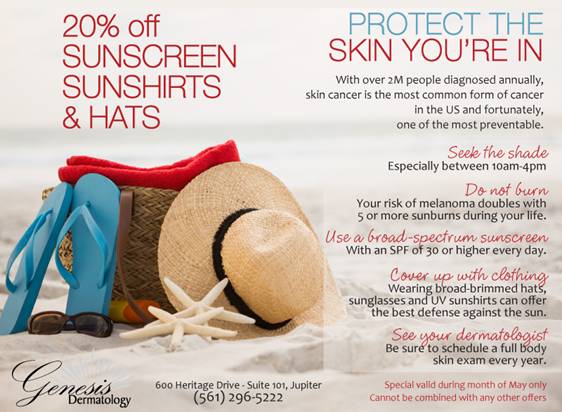
A Refresher on Protecting Your Skin
There is no such thing as a healthy tan! When you tan or burn your skin the top layer becomes damaged, potentially triggering mutations in the DNA of your skin cells, which leads to skin cancer. The Centers for Disease Control and Prevention (CDC) reports that the hours between 10 a.m. and 4 p.m. Daylight Saving Time (9 a.m. to 3 p.m. Standard Time) are the most hazardous for exposure to ultraviolet (UV) radiation.
Because May is Skin Cancer Awareness Month, your board-certified dermatologists at Genesis Dermatology want to remind you about the best ways to protect your skin from the damaging and even deadly rays of the sun. According to the CDC, skin cancer rates have increased significantly in recent years for both white men and white women. (Rates for black, Hispanic, American Indian/Alaska Native, and Asian/Pacific Islander men and women have remained steady from 2003 to 2012, the last year for which data are available.)
Therefore, we’d like to provide a refresher on the best ways to protect yourself against overexposure to sunlight. (And remember that tanning beds result in exactly the same damage—and risk—as the sun.) Here are some tips we highly recommend to keep you safe.
- Sunscreen and lip balm. Of course, it all starts with a good sunscreen. That is, one with a Sun Protection Factor (SPF) of at least 30, which means the length of time you can stay in the sun without burning. If you would normally burn with 20 minutes’ exposure, SPF 30 should protect your skin about 30 times longer. However, because of perspiration and other factors reapplying every 2-3 hours is recommended. Look for one labeled “broad spectrum,” which protects against both UVA (the skin-damaging rays) and UVB rays (responsible for sunburn) and preferably one with zinc oxide which is a physical barrier to the sun and not a chemical. If your skin is sensitive to sunscreen, use one that is free of all preservatives, para-aminobenzoic acid (PABA), chemicals, perfumes, and alcohol.
- Watch the reflection. Here in South Florida, we often forget there is more than one way for the damaging rays of the sun to find us. We think if we’re sitting under an umbrella, we’re safe. But reflected sunlight can bounce off water, cement, and white sand, up and under the umbrella and sunhat. If it’s sunny, you’re at risk of sun exposure and sunburn when outdoors.
- Stay in the shade. Providing there are no reflective surfaces nearby, you’ll be safe if you stay in the shade. If you must be in the sun, wear a broad-brimmed hat that shades your face, head, ears, and neck, and wear clothing made of sun-protective fabric that covers your arms and legs.
- Close the blinds. Recent research has shown that, contrary to popular belief, much of the damaging UV rays from the sun can pass through glass, so if you’re sitting by the window, either pull the shades or apply sunscreen.
For more information on how to protect your skin from sun damage, as well as how to repair damage already done, please feel free to contact us. Since 95% of all skin cancers are curable if caught in time, we can help you avoid the consequences of this deadly disease.

